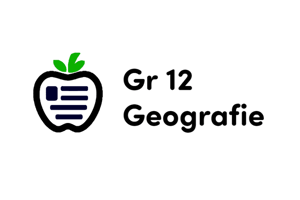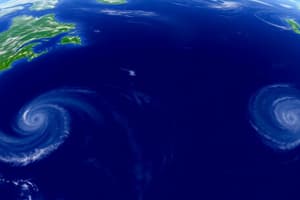Podcast
Questions and Answers
What are the sectors of a mid-latitude cyclone?
What are the sectors of a mid-latitude cyclone?
- Stationary front
- Frontal wave
- Open wave
- All of the above (correct)
Where do mid-latitude cyclones commonly form?
Where do mid-latitude cyclones commonly form?
Middle latitudes in the winter.
What happens to the warm air at the cold front in a mid-latitude cyclone?
What happens to the warm air at the cold front in a mid-latitude cyclone?
It rises and creates a low pressure cell.
Match the stages of the life cycle of a mid-latitude cyclone:
Match the stages of the life cycle of a mid-latitude cyclone:
What is a Nor'easter?
What is a Nor'easter?
What is a mid-latitude cyclone?
What is a mid-latitude cyclone?
What is lee side cyclogenesis?
What is lee side cyclogenesis?
What is a Colorado Low?
What is a Colorado Low?
What characterizes a Gulf Low?
What characterizes a Gulf Low?
What is an occluded front?
What is an occluded front?
What is an Alberta Clipper?
What is an Alberta Clipper?
Flashcards are hidden until you start studying
Study Notes
Mid Latitude Cyclones Overview
- Mid-latitude cyclones originate as low pressure systems along the polar front, where warm air collides with cold air.
- The development of a wave leads to the formation of distinct warm and cold fronts, resulting in a decrease of pressure.
- As cyclones intensify, they exhibit a counterclockwise rotation in the Northern Hemisphere and a clockwise rotation in the Southern Hemisphere.
- Cyclones typically travel from west to east and can last several days to a week.
Formation of Mid Latitude Cyclones
- Most commonly develop during winter at middle latitudes due to the close presence of warm and cold fronts.
- The interaction between these fronts contributes to cyclone formation and intensification.
Weather Patterns in Mid Latitude Cyclones
- Warm air rises at the cold front, creating a low-pressure cell and drawing winds into the system.
- The rising moist air leads to precipitation, which can manifest as rain or snow, depending on temperature.
Life Cycle of a Mid Latitude Cyclone
- Phases include: stationary front, frontal wave, open wave, mature (initial occlusion), advanced occlusion, and cut-off cyclone.
- The occlusion phase occurs when the cold front "catches up" to the warm front, signaling the storm's peak strength.
- Jet streams guide the movement of the cyclone eastward throughout its life cycle.
Case Study: Nemo
- Specific details on the case study of Cyclone Nemo are not provided.
Nor'easter
- A significant macro-scale storm that typically affects the East Coast.
- The term derives from the wind's direction originating from the northeast.
- Cold low-pressure systems can gather moisture from the ocean, resulting in heavy snowstorms and potential damage.
Key Definitions
- Mid-latitude cyclone: A cyclone occurring in the mid-latitudes at the polar front.
- Lee side cyclogenesis: The stretching of air columns descending on the lee side of elevated terrains like mountains.
- Colorado Low: A type of lee-side low where westerly winds intensify low pressure as they descend on the eastern side of a mountain range.
- Gulf Low (Texas Low): A low-pressure system that forms over the Gulf of Mexico and moves northeast alongside the Appalachian Mountains.
- Occluded front: A boundary where a warm air mass is trapped between two colder air masses, usually bringing cool temperatures and significant precipitation.
- Alberta Clipper: A fast-moving low-pressure system affecting Canada and the upper Midwest, often leading to snow and harsh winds.
Studying That Suits You
Use AI to generate personalized quizzes and flashcards to suit your learning preferences.




